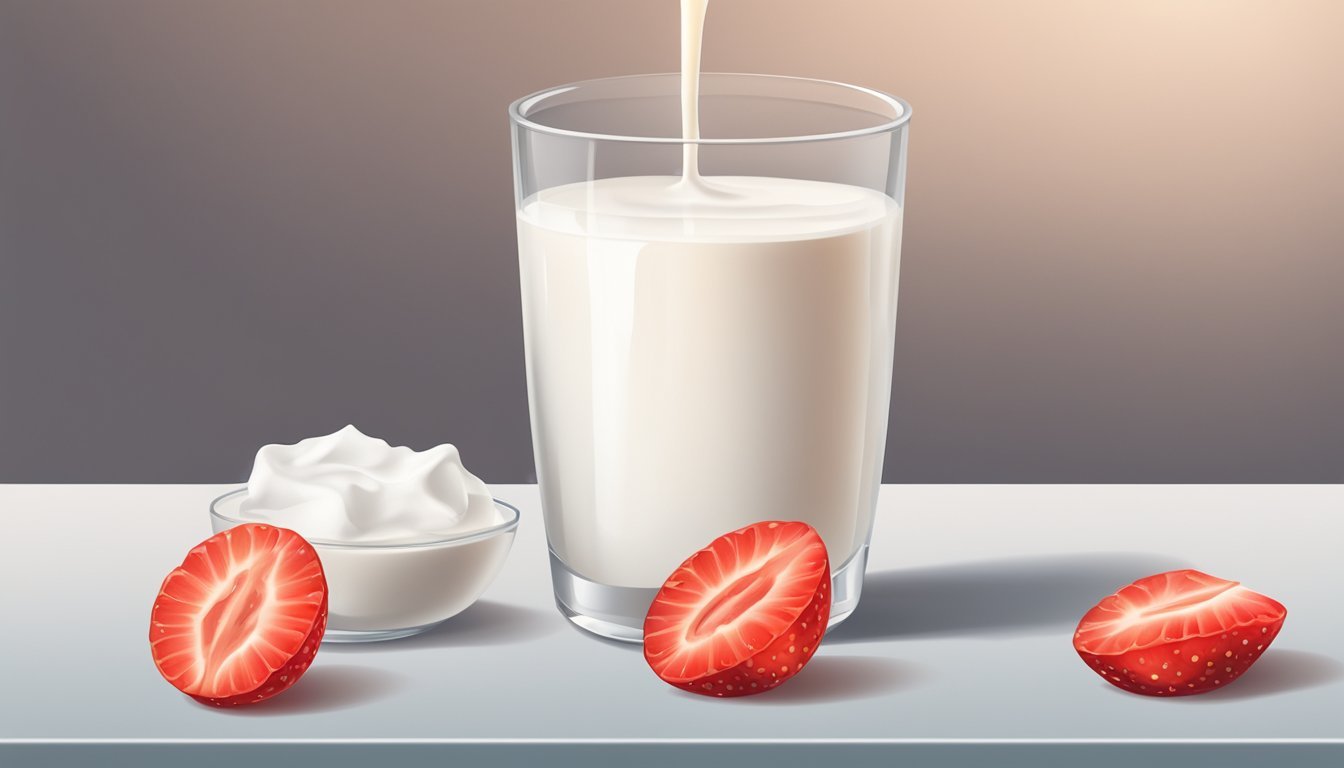Can Lactose Intolerance Cause Acne?
Exploring the Connection
Lactose intolerance and its connection to acne have been subjects of interest within dermatological research. Lactose intolerance generally refers to the body's inability to properly digest lactose, a type of sugar found in milk and dairy products, due to a deficiency of the enzyme lactase. This condition typically leads to digestive issues such as bloating, gas, and diarrhea after the consumption of dairy. Acne, on the other hand, is a common skin condition characterized by pimples, blackheads, and inflamed cysts, commonly arising from hormonal fluctuations, bacteria, and clogged pores.
Studies have explored the relationship between dairy consumption and acne, with mixed results. Some research indicates that certain dairy products, particularly low-fat and skim milk, may be linked to the prevalence of acne due to the presence of hormones or bioactive molecules that may exacerbate the condition. It is thought that these components could potentially interact with human hormones and inflammation pathways that contribute to acne development.
However, contrasting findings suggest that lactose intolerant individuals may have a lower incidence of acne, implying that regular consumption of lactose may have a different impact than previously considered. The exact mechanisms of how lactose intolerance and dairy intake relate to acne development are complex and not fully understood, underlining the need for further research to clarify these connections.
Understanding Acne
Acne, a complex skin condition, involves various factors such as sebum production and bacteria. These contribute to the manifestation of symptoms like blackheads and cysts.
What Is Acne Vulgaris?
Acne Vulgaris is a common skin condition characterized by the presence of pustules, blackheads, whiteheads, and sometimes cysts. It primarily occurs when pores on the skin become clogged with excess sebum, an oily substance produced by the sebaceous glands, and dead skin cells. The blockage can lead to inflammation and the development of skin breakouts.
Pustules: Inflamed lesions that are typically filled with pus
Blackheads (open comedones): Appearing as small, dark spots on the skin due to oxidized melanin
Whiteheads (closed comedones): Small, flesh-colored papules with a white tip
Cysts: Deep, painful, pus-filled lesions that can cause scarring
Causes and Symptoms of Acne
The causes of acne are multifactorial, with key elements being:
Sebum Production: Overproduction can lead to pores becoming clogged.
Bacteria: Propionibacterium acnes (P. acnes) colonize the sebum-filled follicles, contributing to inflammation.
Dead Skin Cells: Accumulation of dead skin cells can block pores.
Hormonal Changes: Often trigger increased sebum production, particularly during puberty, menstruation, or pregnancy.
Symptoms of acne may include:
Visible Comedones: Both open (blackheads) and closed (whiteheads)
Redness and Swelling: Around the affected pores
Tenderness or Pain: In inflamed lesions
Scarring: Can result from severe or untreated acne
It is crucial to understand these elements to effectively address and manage acne.
Lactose Intolerance Explained
Lactose intolerance is a common digestive issue where the body lacks the enzyme necessary to break down lactose, leading to a range of symptoms after consuming dairy.
What Causes Lactose Intolerance?
Lactose intolerance occurs when the small intestine does not produce enough of an enzyme called lactase, which is essential for digesting lactose, the sugar found in milk and dairy products. Without adequate lactase, lactose remains undigested and causes gastrointestinal symptoms as it passes through the colon.
The condition can be inherited, or it can develop later in life due to other factors such as illness or injury to the small intestine. Three types of lactose intolerance are known:
Primary lactose intolerance: The most common type where lactase production decreases with age.
Secondary lactose intolerance: Caused by illness or injury that affects the intestine.
Congenital lactose intolerance: A rare genetic disorder where lactase enzyme production is minimal from birth.
Recognizing Lactose Intolerance Symptoms
Individuals who are lactose intolerant typically experience gastrointestinal symptoms shortly after consuming lactose-containing foods. Common symptoms include:
Diarrhea: Often occurs 30 minutes to 2 hours after eating.
Gas: Caused by the fermentation of lactose by bacteria in the colon.
Bloating: An uncomfortable sensation of fullness.
Abdominal cramps: Caused by the buildup of gas and disrupted digestion.
Some lactose-intolerant adults may also experience nausea, which can sometimes lead to vomiting. Recognizing these symptoms is crucial for managing the condition and avoiding discomfort.
Linking Diet and Skin Health
The relationship between dietary habits and the health of the skin is an area of increasing interest within dermatological research. Certain diets and food groups, particularly those prevalent in Western lifestyles, have been associated with skin conditions such as acne.
Impact of Diet on Skin Condition
Advances in nutritional science have made it evident that diet plays a vital role in skin health. Foods with a high glycemic index (GI) or glycemic load (GL) can provoke hormonal fluctuations that may lead to skin issues. For instance, diets high in sugars and refined carbohydrates result in a rapid increase in insulin levels, which can exacerbate skin conditions, including acne.
Conversely, diets rich in low-glycemic foods tend to promote more stable blood sugar levels and possibly, healthier skin. The inclusion of omega-3 fatty acids, antioxidants, vitamins, and minerals in one's diet can support skin health. Hydration is also crucial, as sufficient water intake is beneficial for maintaining skin moisture and elasticity.
The Western Diet and Skin Concerns
The Western diet, characterized by high consumption of red meats, dairy products, sugars, and refined grains, has been linked with the prevalence of acne in certain populations. Diets in this category typically have a high glycemic index and load, potentially triggering the skin to produce excess oil and contribute to the development of acne.
Studies suggest a correlation between dairy intake and acne, implying that hormones present in milk may influence endogenous hormones and sebaceous gland activity. The case for a direct causative relationship, however, remains debated, with individual responses to dairy consumption varying significantly. The role of dairy as a factor in other skin conditions is also subject to ongoing research.
In considering the impact of diet on skin health, individual responses prevail. Dietary patterns and specific nutritional components can influence skin health differently across various populations.
The Dairy and Acne Connection
Recent inquiries and research suggest a complicated relationship between dairy products and acne, implicating hormones found in milk as potential exacerbators of skin conditions.
Dairy Products and Acne Incidence
Consumption of dairy products, particularly milk, has been observed to correlate with the incidence of acne. The data imply that individuals who consume a higher quantity of dairy tend to report more cases of the skin condition. For example:
Milk: Regular intake has been linked to a rise in acne occurrence.
Cheese and Yogurt: Varying effects but also associated with acne in some studies.
Scientific Studies on Dairy and Acne
Multiple scientific studies have evaluated the potential association between dairy intake and the prevalence of acne. Exploring various age groups and diets, research highlights that the connection is not uniform but varies across individuals. Key findings include:
A meta-analysis from observational studies indicated a trend where dairy intake could be linked to acne development in youth.
Another study pointed to fermented milk products containing lactoferrin as having a potential benefit in reducing acne lesions.
Hormones in Milk and Acane Relation
The hormones present in dairy milk, such as IGF-1, growth hormones, and artificial hormones, can potentially influence acne. These hormones may increase insulin levels or create imbalances that lead to skin changes. Specifically:
IGF-1: Insulin-like growth factor 1, found in cow's milk, may exacerbate acne by increasing sebum production.
Artificial Hormones: Although their direct effect on acne remains under examination, apprehensions exist regarding their impact on the human endocrine system.
Evidence and Research Findings
Recent research has aimed to clarify the relationship between lactose intolerance and acne, yielding several studies and analyses that provide insight into the potential associations.
Observational Studies Overview
Various observational studies have focused on discerning whether lactose intolerance contributes to the presence or severity of acne. Though these studies typically do not establish causality, they do reveal patterns that can suggest a link or lack thereof. Some researchers have looked at different populations to gauge the frequency of acne among those with lactose intolerance compared to those without it.
Meta-Analysis Reports
Meta-analyses bring together data from numerous studies to produce a more comprehensive understanding of acne's relation to dairy consumption, which is inherently related to lactose intolerance. The robustness of a meta-analysis lies in its ability to minimize biases present in individual studies and to provide a larger sample size for review by aggregating results. For example, a notable meta-analysis gathered data from several studies encompassing tens of thousands of individuals to examine the potential connection between dairy intake and the development of acne.
Retrospective Cross-Sectional Analysis
Retrospective cross-sectional analyses offer another angle, comparing past data across different groups to ascertain correlations. In this case, researchers have used this approach to examine the incidence of acne in individuals identified as lactose intolerant versus lactose tolerant. This type of study can inform whether lactose intolerance may be associated with a lower or higher prevalence of acne in populations.
Types of Dairy Linked to Acne
The relationship between dairy products and acne centers on the different effects of milk's fat content and the way various dairy products are processed.
Skim vs. Whole Milk
Skim Milk:
Association with Acne: Several studies suggest a stronger link between low-fat and skim milk consumption and acne prevalence compared to whole milk.
Potential Reason: Skim milk has more milk sugars per serving, which may impact insulin levels, contributing to acne development.
Acne Connection: Evidence regarding whole milk's effect on acne is less consistent, with some research showing no significant impact.
Milk Fat Content: Whole milk retains its natural fat content, which may alter how hormones affecting acne are processed by the body.
Cheese, Yogurt, and Acne
Cheese:
Variables such as fat content and processing methods make it challenging to generalize cheese's impact on acne.
Individual reactions to cheese vary, and some may find a link with acne breakouts, potentially due to hormones present in milk.
Yogurt:
Fermented Dairy: Yogurt is a fermented product which can have probiotic benefits, potentially mitigating acne for some individuals.
Studies and Findings: Certain studies point to yogurt having less of an impact on acne than other forms of dairy, attributed to the fermentation process.
When considering dairy consumption, one should be mindful not only of the type of dairy product but also of individual health responses and potential underlying susceptibilities to acne.
Other Factors Influencing Acne
While diet has been explored as a possible factor in the development of acne, it is important to consider additional influences. Stress and hormonal fluctuations, as well as the cosmetics and skin products used, can significantly impact the skin’s condition.
Stress and Hormonal Fluctuations
Stress has been widely recognized for its role in exacerbating acne. When individuals experience stress, their bodies produce an increased amount of cortisol, a stress hormone, which can lead to an overproduction of oil from the sebaceous glands. This excess oil can clog pores, creating a fertile environment for acne.
Cortisol:
Increase during stress
Leads to excess oil production
Hormonal changes during puberty, pregnancy, and the menstrual cycle also play a critical role. Androgens, which are hormones that increase during puberty, can cause sebaceous glands to enlarge and produce more sebum. This hormonal surge is not exclusive to adolescence, as it can reoccur during a woman's menstrual cycle or pregnancy, leading to what is often referred to as hormonal acne.
Hormonal Fluctuations:
Puberty: Rise in androgens; increased sebum production
Menstrual Cycle: Hormonal shifts can precipitate breakouts
Pregnancy: Hormonal fluctuations may lead to changes in skin condition
Cosmetics and Skin Products
The choice of cosmetics and skin products is instrumental in managing acne. Products that are non-comedogenic are formulated to not clog pores, which is crucial for people prone to acne. Conversely, certain makeup and skincare products contain ingredients that may irritate the skin or exacerbate acne.
Non-comedogenic Products:
Designed to not clog pores
Essential for acne-prone skin
The use of makeup can contribute to acne if it is oil-based, as it adds an extra layer that can trap dead skin cells and bacteria, leading to breakouts. Individuals should opt for products labeled oil-free or non-acnegenic to minimize potential skin irritation.
Makeup Considerations:
Oil-based products can trap debris in pores
"Oil-free" or "non-acnegenic" labels are preferable
Managing Acne for Lactose Intolerant Individuals
Lactose intolerant individuals may experience improvements in acne by making specific dietary adjustments and utilizing appropriate medical treatments.
Dietary Adjustments and Alternatives
For those who are lactose intolerant, dairy products are often eliminated or reduced in their diet. This can inadvertently impact acne, as studies suggest a correlation between dairy intake and the prevalence of acne.
Lactose-Free Dairy Products: They can opt for lactose-free milk and dairy alternatives that do not trigger their intolerance symptoms. Options include lactose-free cow's milk, and non-dairy alternatives like almond, soy, or oat milk.
Probiotic Foods: Including probiotic-rich foods such as kefir, kimchi, and sauerkraut can support gut health, which might influence skin health positively.
Balanced Diet: Maintaining a diet that includes a variety of fruits, vegetables, whole grains, and lean proteins can support overall health, including the skin.
Note: When making dietary changes, individuals should ensure they still meet their nutritional needs, possibly with the help of a registered dietitian or nutritionist.
Medical and Over-the-Counter Treatments
Apart from diet, other treatments exist to manage acne effectively for lactose intolerant patients.
Topical Retinoids: These vitamin A derivatives help in preventing clogged pores and are available both over-the-counter and by prescription.
Benzoyl Peroxide: It has antibacterial properties and can be found in various cleansers and creams.
Salicylic Acid: This helps to exfoliate the skin and is available in numerous skincare products.
Oral Medications: For more severe cases, dermatologists may prescribe oral antibiotics or isotretinoin.
Important: Before starting any new medication or treatment, a consultation with a healthcare professional is essential to ensure its suitability for an individual's specific circumstances.
Professional Insights and Recommendations
Renowned dermatologists and the American Academy of Dermatology provide guidance on the relationship between diet and acne, focusing on the impact of lactose intolerance and dairy consumption.
Dermatologist's Perspective on Acne and Diet
Many board-certified dermatologists observe that diet can influence skin condition, including acne. Specifically, they note that dairy, particularly skim milk, may exacerbate acne in some individuals. The effect of lactose intolerance on acne prevalence is less clear. A licensed dermatologist might suggest an elimination diet to determine if dairy is contributing to acne.
Impact of Lactose Intolerance: Lactose intolerant individuals may experience fewer acne-related issues due to reduced dairy consumption.
Dairy Products: Some dermatologists believe that dairy products, especially those with high sugar content or hormone levels, can trigger or worsen acne.
Nutritional Advice: A dermatologist may recommend dietary modifications along with topical or oral medications to manage acne effectively.
American Academy of Dermatology Guidelines
The American Academy of Dermatology (AAD) provides evidence-based guidelines for the management of acne. They recognize the potential connection between dairy intake and acne development, and suggest:
Dairy and Acne: The AAD notes that certain dairy products may be linked to acne but does not recommend complete elimination without consultation.
Patient Education: Education on the variety of factors contributing to acne is part of the AAD's comprehensive approach to acne treatment.
Evidence-Based Recommendations: Treatments are tailored to the individual, taking into account the possible effects of diet, based on current evidence and patient history.
Future Directions and Research
Recent findings prompt further exploration into how dietary changes influence acne vulgaris, with a keen interest in the role of lactose as a contributing factor. There is a growing recognition of the mTORC1 pathway's involvement in acne and its modulation by diet.
Emerging Trends in Acne Treatment
The advancement of acne treatment is increasingly focusing on the interplay between diet and skin health. Researchers are looking into how modulating dietary patterns affect acne's pathogenesis, particularly through the mTORC1 signaling pathway, which is known for regulating cell growth and proliferation and is believed to be a potential target for novel treatments. The inquiry into specific food groups such as dairy and high-glycemic-index foods is gaining traction as these are suspected to exacerbate acne. Future treatment modalities may include:
Personalized Nutrition Plans: Based on individual responses to foods, these plans may decrease the activation of mTORC1, potentially reducing acne severity.
Supplements: The use of supplements to either reduce inflammation or directly inhibit mTORC1 signaling.
The Ongoing Research into Acne and Lactose Intolerance
The relationship between lactose intolerance and acne is under active investigation, which may reshape the understanding of acne's epidemiology. Clinical studies are compiling data to cement the possible correlation between lactose intolerance and the occurrence of acne. Upcoming research aims to establish whether the absence of lactose in the diet of those intolerant to it leads to a lower incidence of acne or reduces severity. Key research efforts include:
Epidemiological Studies: Detailed analyses of large patient groups to determine the prevalence of acne in lactose intolerant individuals versus those without this intolerance.
Clinical Trials: Controlled trials assessing the impact of eliminating lactose-containing products in patients' diets on acne improvement.
Through rigorous scientific methods, these approaches seek to confirm or refute the link between lactose and acne, potentially leading to tailored dietary recommendations for acne prevention and management.









